Thermal Alteration of Organic Matter in the Contact of a Rift-Related Basaltic Dyke: An Example from the Black Limestone, Wadi Matulla, West Central Sinai, Egypt
Abstract
1. Introduction
2. Geologic Setting
2.1. Rift-Related Volcanic Activity: Sub-Aerial vs. Sub-Aqueous Vulcanicity
2.2. The Study Area
Structural and Stratigraphic Framework
3. Methodology
3.1. Total Organic Carbon (TOC)
3.2. Sample Preparation and TOC Measurement
4. Results
4.1. The Petrography
4.1.1. The Sudr Formation
4.1.2. The Basalt
4.2. The Thermal Effect of the Dyke
4.2.1. The Baked Zone
4.2.2. The Thermal Aureole
4.2.3. The Metasomatic Effect
5. Discussion
5.1. The Source of Heat and Heat Transfer Mechanism
5.2. The Source of H2O
5.3. Organic Matter, Organic Carbon (OC), and Total Organic Carbon (TOC)
5.4. TOC, Thermal Maturation, and the Origin of the Baked Zone
6. Implications of the Present Study
Local Maturation of Source Rock-Prone Formations in the GOS Region
7. Conclusions
Author Contributions
Funding
Acknowledgments
Conflicts of Interest
References
- Palumbo, F.; Main, I.G.; Zito, G. The thermal evolution of sedimentary basins and its effect on the maturation of hydrocarbons. Geophys. J. Int. 1999, 139, 248–260. [Google Scholar] [CrossRef][Green Version]
- Roberts, L.N.R.; Lewan, M.D.; Finn, T.M. Burial History, Thermal Maturity, and Oil and Gas Generation History of Petroleum Systems in the Southwestern Wyoming Province, Wyoming, Colorado, and Utah. In Petroleum Systems and Geologic Assessment of Oil and Gas in the Southwestern Wyoming Province, Wyoming, Colorado, and Utah, 1st ed.; USGS: Denver, CO, USA, 2005. [Google Scholar]
- Grobe, A.; Littke, R.; Sachse, V.; Leythaeuser, D. Burial history and thermal maturity of Mesozoic rocks of the Dolomites, Northern Italy. Swiss J. Geosci. 2015, 108, 253–271. [Google Scholar] [CrossRef]
- Simandl, G.J.; Paradis, S.; Akam, C. Graphite deposit types, their origin, and economic significance. In Symposium on Strategic and Critical Materials; British Columbia Geological Survey: Victoria, BC, Canada, 2015. [Google Scholar]
- Beyssac, O.; Brunet, F.; Petitet, J.P.; Goffe, B.; Rouzaud, J.N. Experimental study of the microtextural and structural transformation of carbonaceous material under pressure and temperature. Eur. J. Min. 2003, 15, 937–951. [Google Scholar] [CrossRef]
- Buseck, P.R.; Beyssac, O. From organic matter to graphite: graphitization. Elements 2014, 10, 421–426. [Google Scholar] [CrossRef]
- El-Barkooky, A.N.; El-Araby, A. The Tertiary Red Beds of Abu Zenima area, West Central Sinai, Egypt: Their Stratigraphy and Sedimentology. In Proceedings of the 4th Geology of the Arab World, Cairo University, Cairo, Egypt, 1998; pp. 621–642. [Google Scholar]
- El-Barkooky, A.N.; El-Araby, A.; Gaupp, R. Early Syn-Rift Deposition of alluvial-lacustrine facies in Wadi Nukhul, West Central Sinai. Egypt. Egypt. J. Geol. 2006, 50, 141–169. [Google Scholar]
- Shallaly, N.A.; Beier, C.; Haase, K.M.; Hammed, M.S. Petrology and geochemistry of the Tertiary Suez rift volcanism, Sinai, Egypt. J. Volcan. Geother. Res. 2013, 267, 119–137. [Google Scholar] [CrossRef]
- Peters, K.E. Guidelines for Evaluating Petroleum Source Rocks using Programmed Pyrolysis. Aapg Bull. 1986, 70, 318–329. [Google Scholar]
- Bosworth, W. Geological Evolution of the Red Sea: Historical Background, Review, and Synthesis. In The Red Sea; Rasul, N.M.A., Stewart, I.C.F., Eds.; Springer Earth System Sciences: Berlin/Heidelberg, Germany, 2015; pp. 45–78. [Google Scholar] [CrossRef]
- Simoneit, B.R.T.; Brenner, S.; Peters, K.E.; Kaplan, I.R. Thermal alteration of Cretaceous black shale by diabase intrusions in the eastern Atlantic. Part II. Effects on bitumen and kerogen. Geochim. Cosmochim. Acta 1981, 45, 1581–1602. [Google Scholar] [CrossRef]
- Akiyama, M.; Hirata, S.; Ujiie, Y. Thermal alteration of kerogen by basalt dykes intruded in the Oligocene Poronai Formation, Hokkaido, Japan. J. Fac. Sci. 1979, 19, 149–156. [Google Scholar]
- Schiener, E.J.; Perregaard, J. Thermal maturation of organic matter by a thick basaltic sill in Upper Cretaceous shales, Svartenhuk Halve, Central West. Greenland. Greenl. Geol. Surv. 1981, 102, 16. [Google Scholar]
- Clayton, J.L.; Bostick, N.H. Temperature effects on kerogen and on molecular and isotopic composition of organic matter in Pierre Shale near an igneous dike. Org. Geochem. 1986, 10, 135–143. [Google Scholar] [CrossRef]
- Bishop, A.N.; Abbott, C.D. Vitrinite reflectance and molecular geochemistry of Jurassic sediments: The influence of heating by Tertiary dyke (northwest Scotland). Org. Geochem. 1995, 22, 165–177. [Google Scholar] [CrossRef]
- Galushkin, Y.I. Thermal effects of igneous intrusions on maturity of organic matter: A possible mechanism of intrusion. Org. Geochem. 1997, 26, 645–658. [Google Scholar] [CrossRef]
- Worden, R.H.; Smalley, P.C.; Cross, M.M. The influence of rock fabric and mineralogy on thermochemical sulfate reduction: Khuff Formation. Abu Dhabi. J. Sed. Res. 2000, 70, 1210–1221. [Google Scholar] [CrossRef]
- Worden, R.H.; Smalley, P.C.; Barclay, S.A. H2S and diagenetic pyrite in North Sea sandstones: due to TSR or organic sulphur compound cracking? J. Geochem. Explor. 2003, 78–79, 487–491. [Google Scholar] [CrossRef]
- Stewart, A.K.; Massey, M.; Padgett, P.L.; Rimmer, S.M.; Hower, J.C. Influence of a basic intrusion on the vitrinite reflectance and chemistry of the Springfield (No. 5) coal, Harrisburg, Illinois. Int. J. Coal Geol. 2005, 63, 58–67. [Google Scholar] [CrossRef]
- Wang, D.; Lu, X.; Zhang, X.; Xu, S.; Hu, W.; Wang, L. Heat-model analysis of wall rocks below a diabase sill in Huimin Sag, China compared with thermal alteration of mudstone to carbargilite and hornfels and with increase of vitrinite reflectance. Geophys. Res. Lett. 2007, 34, L16312. [Google Scholar] [CrossRef]
- Mastalerz, M.; Drobniak, A.; Schimmelmann, A. Changes in optical properties, chemistry, and micropore and mesopore characteristics of bituminous coal at the contact with dikes in the Illinois Basin. Int. J. Coal Geol. 2009, 77, 310–319. [Google Scholar] [CrossRef]
- Schimmelmann, A.; Mastalerz, M.; Gao, L.; Sauer, P.E.; Topalov, K. Dike intrusions into bituminous coal, Illinois Basin: H, C, N, O isotopic responses to rapid and brief heating. Geochim. Cosmochim. Acta 2009, 73, 6264–6281. [Google Scholar] [CrossRef]
- Aarnes, I.; Svensen, H.; Connolly, J.A.D.; Podladchikov, Y.Y. How contact metamorphism can trigger global climate changes: Modeling gas generation around igneous sills in sedimentary basins. Geochim. Cosmochim. Acta 2010, 74, 7179–7195. [Google Scholar] [CrossRef]
- Aarnes, I.; Svensen, H.; Polteau, S.; Planke, S. Contact metamorphic devolatilization of shales in the Karoo Basin, South Africa, and the effects of multiple sill intrusions. Chem. Geol. 2011, 281, 181–194. [Google Scholar] [CrossRef]
- Cao, X.; Chappell, M.; Schimmelmann, A.; Mastalerz, M.; Li, Y.; Hu, W.; Mao, J. Chemical structure changes in kerogen from bituminous coal in response to dike intrusions as investigated by advanced solid-state 13C NMR spectroscopy. Int. J. Coal Geol. 2013, 108, 53–64. [Google Scholar] [CrossRef]
- Brekke, T.; Krajewski, K.P.; Hubred, J.H. Organic geochemistry and petrography of thermally altered sections of the Middle Triassic Botneheia Formation on south-western Edgeøya, Svalbard. Nor. Pet. Dir. Bull. 2014, 11, 111–128. [Google Scholar]
- Agirrezabala, L.M.; Permanyer, A.; Surez-Ruiz, I.; Dorronsoro, C. Contact metamorphism of organic-rich mudstones and carbon release around a magmatic sill in the Basque-Cantabrian Basin, western Pyrenees. Org. Geochem. 2014, 69, 26–35. [Google Scholar] [CrossRef]
- Schofield, N.; Holford, S.; Millett, J.; Brown, D.; Jolley, D.R.; Passey, S.; Muirhead, D.; Grove, C.; Magee, C.; Murray, J.; et al. Regional magma plumbing and emplacement mechanisms of the Faroe-Shetland Sill Complex: Implications for magma transport and petroleum systems within sedimentary basins. Basin Res. 2015, 29, 41–63. [Google Scholar] [CrossRef]
- Wang, D.; Manga, M. Organic matter maturation in the contact aureole of an igneous sill as a tracer of hydrothermal convection. J. Geophys. Res. Solid Earth 2015, 120, 4102–4112. [Google Scholar] [CrossRef]
- Muirhead, D.K.; Bowden, S.A.; Parnell, J.; Schofield, N. Source rock maturation due to igneous intrusion in rifted margin petroleum systems. J. Geol. Soc. Lond. 2017, 174, 979. [Google Scholar] [CrossRef]
- Reeckmann, S.A.; Mebberson, A.J. Igneous intrusions in the north-west Canning Basin and their impact on oil exploration. In The Canning Basin; Purcell, P.G., Ed.; Geological Society of Australia-Petroleum Exploration Society of Australia: Perth, Australia, 1984; pp. 389–399. [Google Scholar]
- Hubred, J.H. Thermal Effects of Basaltic Sill Emplacement in Source Rocks on Maturation and Hydrocarbon Generation, Cand. Scient. Master’s Thesis, University of Oslo, Oslo, Norway, 2006. [Google Scholar]
- Vasquez, M.; Altenberger, U.; Romer, R.L. Neogene magmatism and its possible causal relationship with hydrocarbon generation in SW Colombia. Int. J. Earth Sci. 2009, 98, 1053–1062. [Google Scholar] [CrossRef]
- Mark, N.J.; Schofield, N.; Pugliese, S.; Watson, D.; Holford, S.; Muirhead, D.; Brown, R.; Healy, D. Igneous intrusions in the Faroe Shetland basin and their implications for hydrocarbon exploration: New insights from well and seismic data. Mar. Petro. Geol. 2018, 92, 733–753. [Google Scholar] [CrossRef]
- Muirhead, D.K.; Duffy, M.; Schofield, N.; Mark, N.; Rowe, M.D. Making Oil from Magma; Geological Society, London, Special Publications: London, UK, 2018; Volume 484. [Google Scholar]
- Patton, T.L.; Moustafa, A.R.; Nelson, R.A.; Abdine, S.A. Tectonic evolution and structural setting of the Suez Rift. In Interior Rift Basins; Landon, S.M., Ed.; AAPG Memoir; American Association of Petroleum Geologists: Tulsa, OK, USA, 1994; Volume 59, pp. 7–55. [Google Scholar]
- Khalil, S.M.; McClay, K.R. Tectonic evolution of the NW Red Sea–Gulf of Suez rift system. In Non-Volcanic Rifting of Continental Margins: A Comparison of Evidence from Land and Sea; Wilson, R.C.L., Whitmarsh, R.B., TAylor, B., Froitzheim, N., Eds.; Geological Society, London, Special Publications: London, UK, 2001; Volume 187, pp. 453–473. [Google Scholar]
- Bosworth, W.; Huchon, P.; McClay, K. The Red Sea and Gulf of Aden Basins. J. Afr. Earth Sci. 2005, 43, 334–378. [Google Scholar] [CrossRef]
- Moustafa, A.R. Structural characteristics and tectonic evolution of the east-margin blocks of the Suez rift. Tectonophysics 1993, 223, 381–399. [Google Scholar] [CrossRef]
- Bosworth, W. A high-strain rift model for the southern Gulf of Suez (Egypt). In Hydrocarbon Habitat in Rift Basins; Lambiase, J.J., Ed.; Geological Society, London, Special Publications: London, UK, 1995; Volume 80, pp. 75–102. [Google Scholar]
- Gawthorpe, R.L.; Jackson, C.A.L.; Young, M.J.; Sharp, I.R.; Moustafa, A.R.; Leppard, C.W. Normal fault growth, displacement localisation and the evolution of normal fault populations: The Hammam Faraun fault block, Suez rift, Egypt. J. Struc. Geol. 2003, 25, 883–895. [Google Scholar] [CrossRef]
- Jackson, C.A.L.; Gawthorpe, R.L.; Leppard, C.W.; Sharp, I.R. Riftinitiation development of normal fault blocks: insights from the Hammam Faraun fault block, Suez Rift, Egypt. J. Geol. Soc. 2006, 163, 165–183. [Google Scholar] [CrossRef]
- Moustafa, A.M. Block faulting of the Gulf of Suez. In Proceedings of the 5th Exploration Seminar, Egyptian General Petroleum Company, Cairo, Egypt, 1976; p. 19. [Google Scholar]
- Faulds, J.E.; Varga, R.J. The role of accommodation zones and transfer zones in the regional segmentation of extended terranes. In Accommodation Zones and Transfer Zones: The Regional Segmentation of the Basin and Range Province; Faulds, J.E., Stewart, J.H., Eds.; Geological Society of America: Boulder, CO, USA, 1998; Volume 323, pp. 1–45. [Google Scholar]
- Moustafa, A.R. Structural setting and tectonic evolution of the northern Hammam Faraun block (Wadi Wasit Wadi Wardan area), eastern side of the Suez rift. J. Univ. Kuwait-Sci. 1996, 23, 105–132. [Google Scholar]
- Moustafa, A.R. Controls on the Geometry of Transfer Zones in the Suez Rift and Northwest Red Sea: Implications for the Structural Geometry of Rift Systems. AAPG Bull. 2002, 86, 979–1002. [Google Scholar]
- Younes, A.I.; McClay, K.R. Development of accommodation zones in the Gulf of Suez-Red Sea rift, Egypt. Am. Assoc. Pet. Geol. Bull. 2002, 86, 1003–1026. [Google Scholar]
- Alsharhan, A.S. Petroleum geology and potential hydrocarbon plays in the Gulf of Suez rift basin, Egypt. Aapg Bull. 2003, 87, 143–180. [Google Scholar]
- Kazmin, V.G.; Byakov, A.F. Magmatism and crustal accretion in continental rifts. J. Afr. Earth Sci. 2000, 30, 555–568. [Google Scholar] [CrossRef]
- Bosworth, W.; McClay, K. Structural and stratigraphic evolution of the Gulf of Suez rift, Egypt: A synthesis. In Peri-Tethys Memoir 6: Peri-Tethyan Rift/wrench Basins and Passive Margins; Ziegler, P.A., Cavazza, W., Robertson, A.H.F., Crasquin-Soleau, S., Eds.; Mémoires du Muséum National d’Histoire Naturelle de Paris: Paris, France, 2001; Volume 186, pp. 567–606. [Google Scholar]
- El-Bialy, M.Z.; Khalifa, I.H.; Omar, M.M. Continental intraplate volcanism in the Sinai subplate: The Oligo-Miocene basalts of the Gulf of Suez rift. J. Afr. Earth Sci. 2017, 146, 158–179. [Google Scholar] [CrossRef]
- Said, R. Cenozoic. In The Geology of Egypt; Said, R., Ed.; CRC Press: Boca Raton, FL, USA, 1990; pp. 451–486. [Google Scholar]
- Moustafa, A.R.; Abdeen, M.M. Structural setting of the Hammam Faraun block, eastern side of the Suez rift. J. Univ., Kuwait Sci. 1992, 19, 291–309. [Google Scholar]
- Sharp, I.R.; Gawthorpe, R.L.; Underhill, J.R.; Gupta, S. Fault propagation folding in extensional settings: Examples of structural style and syn-rift sedimentary response from the Suez Rift, Egypt. Geol. Soc. Amer. Bull. 2000, 112, 1877–1899. [Google Scholar] [CrossRef]
- Bastesen, E.; Braathen, A.; Skar, T. Comparison of scaling relationships of extensional fault cores in tight carbonate and porous sandstone reservoirs. Pet. Geosci. 2015, 19, 385–398. [Google Scholar] [CrossRef]
- Barakat, M.G.; Darwish, M.; El Outefi, N.S. Eocene tectonostratigraphy and basin evaluation in the Gulf of Suez petroliferous province. In Proceedings of the 9th Egyptian General Petroleum Corporation, Petroleum Exploration and Production Conference, Cairo, Egypt, 1988; Volume 1, pp. 1–22. [Google Scholar]
- Abu Khadra, A.M.; Youssef, E.A.A.; Refaat, A. Depositional environments and diagenesis of the Matulla Formation, Abu Zenima area, West-Central Sinai, Egypt. Bull. Fac. Sci. 1990, 58, 493–513. [Google Scholar]
- Abdelhamid, M.A.M. Turonian-Santonian echinoids from Wadi Sudr and Wadi Matulla, west central Sinai. Middle East Res. Cent. Ain Shams Univ. Earth Sci. Ser. 1997, 11, 136–158. [Google Scholar]
- Abdel-Gawad, G.I. Biostratigraphy and macrofossil assemblages of the Matulla Formation (Coniacian–Santonian), west central Sinai, Egypt. Middle East Res. Cent. Ain Shams Univ. Earth Sci. Ser. 1999, 13, 187–202. [Google Scholar]
- Kora, M.; Hamama, H.; Sallam, H. Senonian macrofauna from West-Central Sinai: Biostratigraphy and Paleobiogeography. Egypt. J. Paleontol. 2002, 2, 235–258. [Google Scholar]
- Shahin, A.M. Maastrichtian to Middle Eocene ostracodes from Sinai, Egypt: Systematics, biostratigraphy and paleobiogeography. Rev. De PaléobiologieGenève 2005, 24, 749–779. [Google Scholar]
- Farouk, S. Maastrichtian carbon cycle changes and planktonic foraminiferal bioevents at Gebel Matulla, west-central Sinai, Egypt. Cretac. Res. 2014, 50, 238–251. [Google Scholar] [CrossRef]
- Meneisy, M.Y. Vulcanicity. In The Geology of Egypt; Said, R., Ed.; Balkema, A.A.: Rotterdam, The Netherlands, 1990; pp. 157–172. [Google Scholar]
- Folk, R.L. Practical petrographic classification of limestones. AAPG Bull. 1959, 43, 1–38. [Google Scholar]
- Dunham, R.J. Classification of carbonate rocks according to depositional of texture 1. In Classification of Carbonate Rocks—A Symposium; Ham, W.E., Ed.; American Association of Petroleum Geologists: Tulsa, OK, USA, 1962; Volume 1, pp. 108–121. [Google Scholar]
- Embry, A.F.; Klovan, E.J. Absolute water depth limits of Late Devonian paleoecological zones. Geol. Rdsch. 1972, 61, 672–686. [Google Scholar] [CrossRef]
- Wilson, J.L. Carbonate Facies in Geological History; Springer: Berlin, Germany, 1975; p. 471. [Google Scholar]
- Scholle, P.A.; Ulmer-Scholle, D.S. A Color Guide to Petrography of Carbonate Rocks: Grains, Textures, Porosity, Diagenesis, AAPG Memoir 77; The American Association of Petroleum Geologists: Tulsa, OK, USA, 2003. [Google Scholar]
- Khalifa, M.A.; Farouk, S.; Hassan, A.M. Carbonate platform facies development of the Turonian Wata Formation in Central and Eastern Sinai. Egypt. J. Afr. Earth Sci. 2016, 124, 126–138. [Google Scholar] [CrossRef]
- Bucher, K.; Frey, M. Petrogensis of Metamorphic Rocks, 7th ed.; Springer: Berlin, Germany, 2002; p. 341. [Google Scholar]
- Rice, J.M. Contact metamorphism of impure dolomitic limestone in the Boulder Aureole, Montana. Contrib. Mineral. Petrol. 1977, 59, 237–259. [Google Scholar] [CrossRef]
- Holness, M.B. Fluid flow path and mechanisms of fluid infiltration in carbonates during contact metamorphism: The Beinn an Dubhaich aureole, Skye. J. Meta. Geol. 1997, 15, 59–70. [Google Scholar] [CrossRef]
- Jamtveit, B.; Dahlgren, S.; Austrheim, H. High grade contact metamorphism of calcareous rocks from the Oslo Rift, Southern Norway. Am. Mineral. 1997, 82, 1241–1254. [Google Scholar] [CrossRef]
- Stowell, H.H.; Menard, T.; Ridgway, C.K. Ca-metasomatism and chemical zonation of garnet in contact-metamorphic aureoles, Juneau Gold Belt, southeastern Alaska. Can. Mineral. 1996, 34, 1195–1209. [Google Scholar]
- Kent, A.J.R.; Ashley, P.M.; Fanning, C.M. Metasomatic alteration associated with regional metamorphism: An example from the Willyama Supergroup, South Australia. Lithos 2000, 54, 33–62. [Google Scholar] [CrossRef]
- Ranjbar, S.; Tabatabaei Manesh, S.M.; Mackizadeh, M.A.; Tabatabaei, S.H.; Parfenova, O.V. Geochemistry of major and rare earth elements in garnet of the Kal-e Kafi skarn, Anarak Area, Central Iran: Constraints on processes in a hydrothermal system. Geochem. Inter. 2016, 54, 423–438. [Google Scholar] [CrossRef]
- Hurtig, E.; Brugger, H. Heat conductivity measurements under uniaxial pressure. Tectonophysics 1970, 10, 67–77. [Google Scholar] [CrossRef]
- Lubimova, E.A.; Smirnova, E.V. Heat physical properties of rocks at high temperatures. In Physical Properties of Rocks under High Pressure and Temperature; Trans. of IV All-Union Congress: Tbilisi, Georgia, 1974; pp. 171–172. (In Russian) [Google Scholar]
- Robertson, E.C. Thermal Conductivity of Rocks. U.S. Geological Survey Open File Report; USGS: Denver, CO, USA, 1979; pp. 79–356.
- Kelemen, P.B.; Kikawa, E.; Miller, D.J. Drills into mantle peridotite along the mid-Atlantic ridge from 14°N to 16°N. In Proceedings of the Ocean Drilling Program, Rio de Janeiro, Brazil, 6 May–7 July 2004; Volume 30, pp. 14–19. [Google Scholar]
- Clauser, C.E. Thermal conductivity of rocks and minerals. In Rock Physics and Phase Relations: A Handbook of Physical Constants; Ahrens, T.J., Ed.; American Geophysical Union: Washington, DC, USA, 1995; Volume 3, pp. 105–126. [Google Scholar]
- Poelchau, H.S.; Baker, D.R.; Hantschel, T.; Horsfield, B.; Wygrala, B. Basin simulation and the design of the conceptual basin model. In Petroleum and Basin Evaluation; Welte, D.H., Horsfield, B., Baker, D.R., Eds.; Springer: Berlin, Germany, 1997; pp. 36–41. [Google Scholar]
- Emeis, K.C.; Kvenvolden, K.A. Shipboard organic geochemistry on Joides Resolution. ODP Tech. Notes 1986, 7. [Google Scholar]
- Lampitt, R.S.; Bett, B.J.; Kiriakoulakis, K.; Popova, E.E.; Ragueneau, O.; Vangriesheim, A.; Wolff, G.A. Material supply to the abyssal seafloor in the northeast Atlantic. Prog. Oceanogr. 2001, 50, 27–63. [Google Scholar] [CrossRef]
- Goni, M.A.; O’Connor, A.E.; Kuzyk, Z.Z.; Yunker, M.B.; Gobeil, C.; Macdonald, R.W. Distribution and sources of organic matter in surface marine sediments across the North American Arctic margin. J. Geophy. Res. Ocean. 2013, 118, 4017–4035. [Google Scholar] [CrossRef]
- Hunter, W.R.; Jamieson, A.; Huvenne, V.A.I.; Witte, U. Sediment community responses to marine vs. terrigenous organic matter in a submarine canyon. Biogeosciences 2013, 10, 67–80. [Google Scholar] [CrossRef]
- Mancsuo, J.T.; Seavoy, R.E. Precambrian coal or anthraxolite: A source for graphite in high-grade schists and gneisses. Econ. Geol. 1981, 65, 273–298. [Google Scholar] [CrossRef]
- Hollister, V.F. Origin of graphite in the Duluth Complex. Econ. Geol. 1980, 75, 764–766. [Google Scholar] [CrossRef]
- Disssanayake, C.B. The Origin of graphite of Sri Lanka. Org. Geochem. 1981, 3, 1–7. [Google Scholar] [CrossRef]
- Soman, K.; Lobzova, R.V.; Sivadas, K.M. Geology, genetic types, and origin of graphite in South Kerala, India. Econ. Geol. 1986, 81, 997–1002. [Google Scholar] [CrossRef]
- Shaheen, A.N.; Shehab, M. Petroleum generation, migration and occurrence in the Gulf of Suez offshore, south Sinai. In Proceedings of the 17th Egyptian General Petroleum Corporation, Petroleum Exploration and Production, Cairo, Egypt, 1984; Volume 1, pp. 126–152. [Google Scholar]
- Atef, A. Source rock evaluation of the Brown Limestone (upper Senonian), Gulf of Suez. In Proceedings of the 9th Egyptian General Petroleum Corporation; Petroleum Exploration and Production, Cairo, Egypt, 1988; Volume 1, pp. 256–275. [Google Scholar]
- Moustafa, A.R.; Klitzsch, E.; Matheis, G.; Ganz, H. Origin and evaluation of hydrocarbons in the Gulf of Suez Basin, Egypt. In Geoscientific Research in North East Africa; Thorweihe, U., Schandelmeier, H., Eds.; CRC Press: Boca Raton, FL, USA, 1993; pp. 267–275. [Google Scholar]
- Alsharhan, A.S.; Salah, M.G. Geology and hydrocarbon habitat in rift setting: Southern Gulf of Suez, Egypt. Bull. Can. Petro. Geol. 1994, 42, 312–331. [Google Scholar]
- Alsharhan, A.S.; Salah, M.G. Geology and hydrocarbon habitat in rift setting: Northern and central Gulf of Suez, Egypt. Bull. Canad. Pet. Geol. 1995, 43, 156–176. [Google Scholar]
- Pearson, D.L. Pollen/Spore Colour “Standard”; Version 2, Phillips Petroleum Company Exploration Projects Section; Phillips Petroleum Company, Privately distributed: Bartlesville, OK, USA, 1984. [Google Scholar]

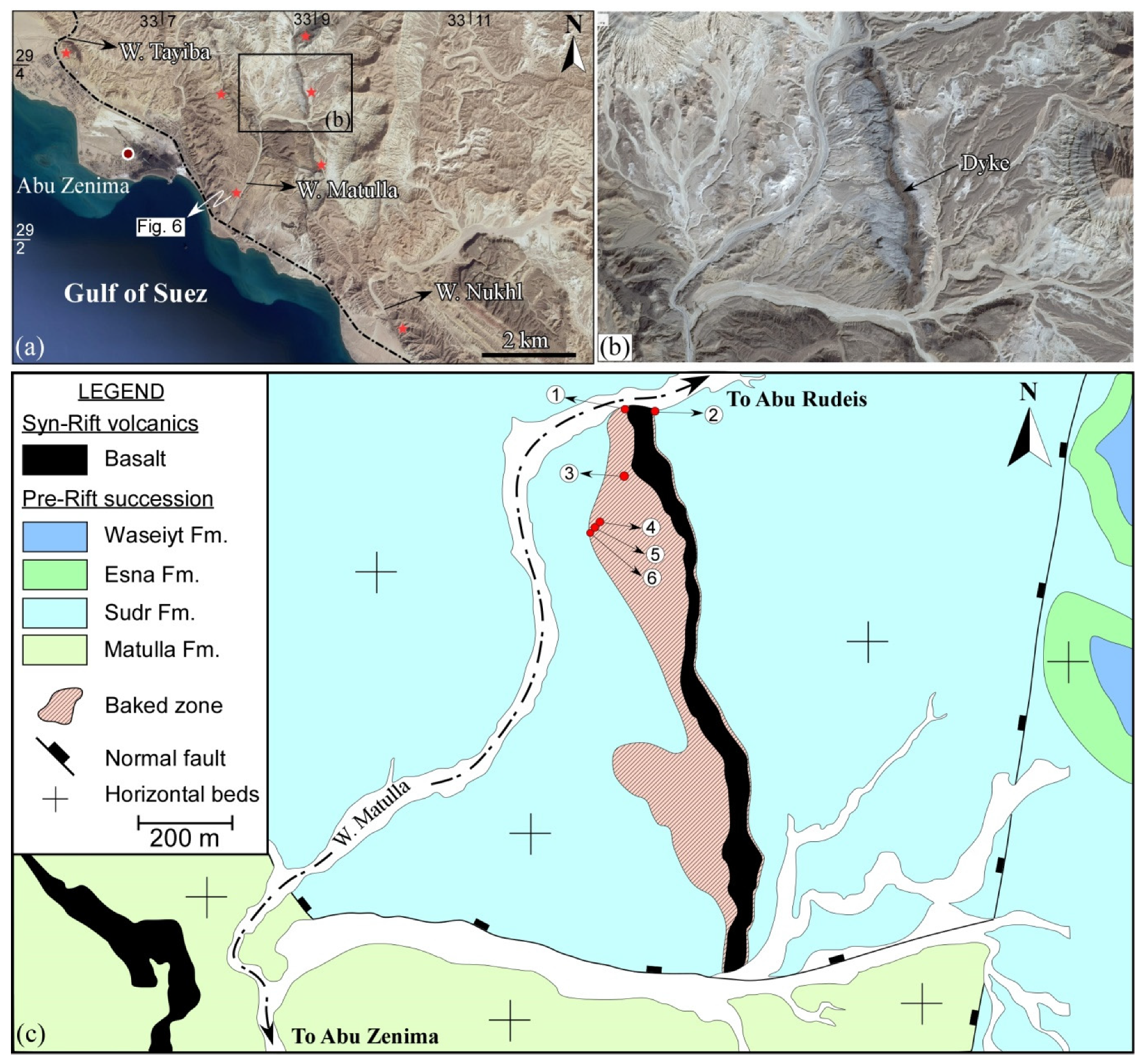
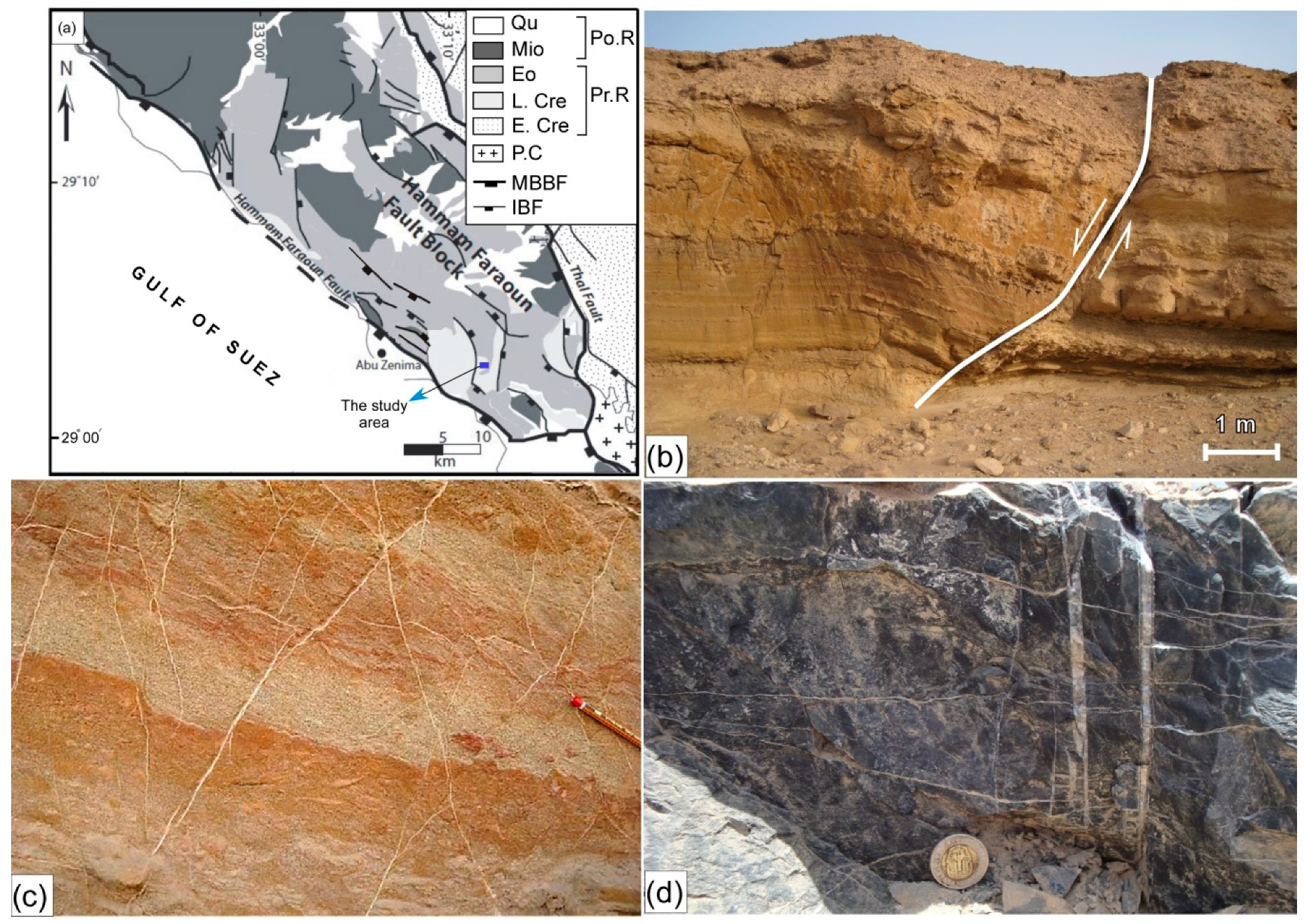
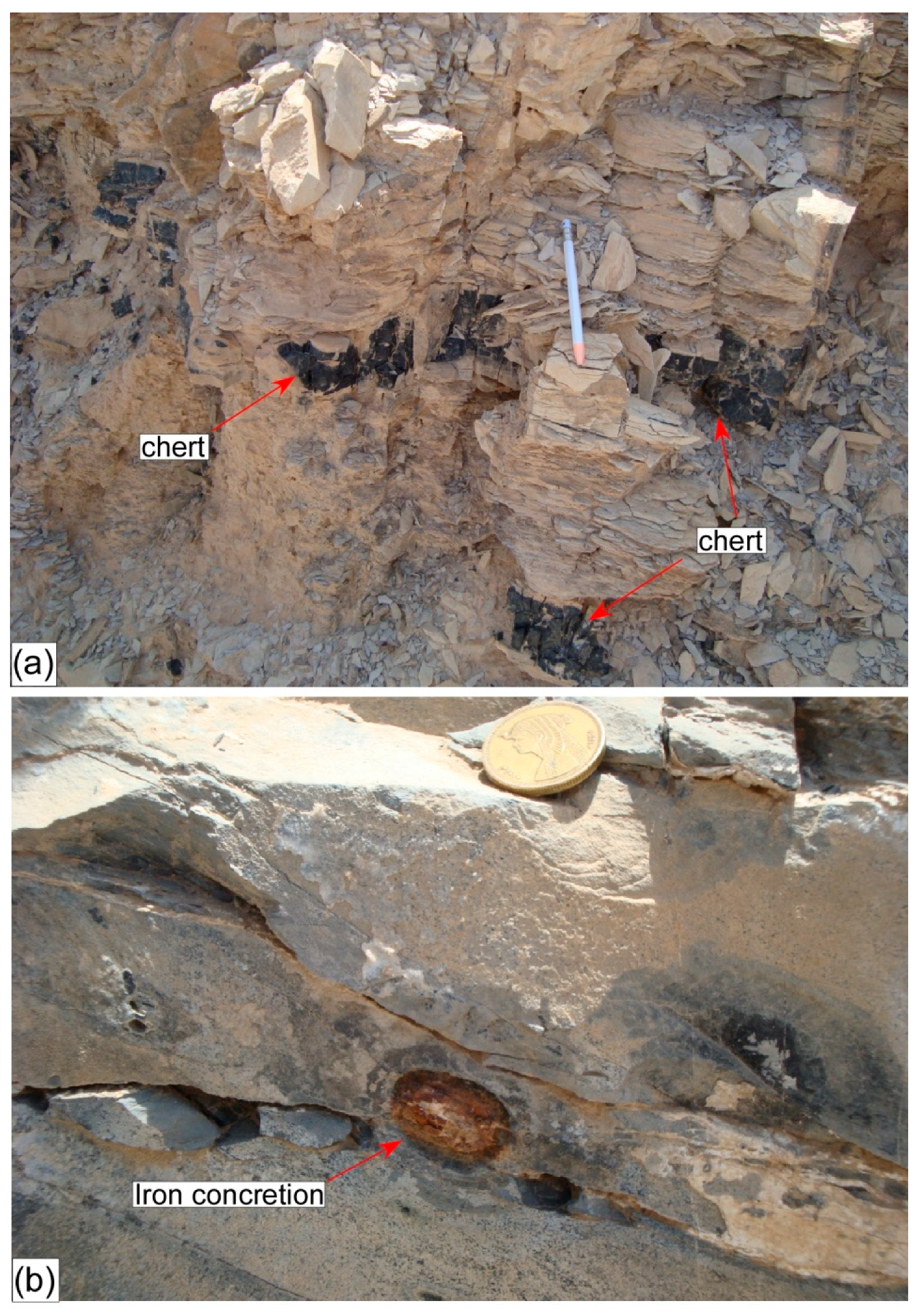

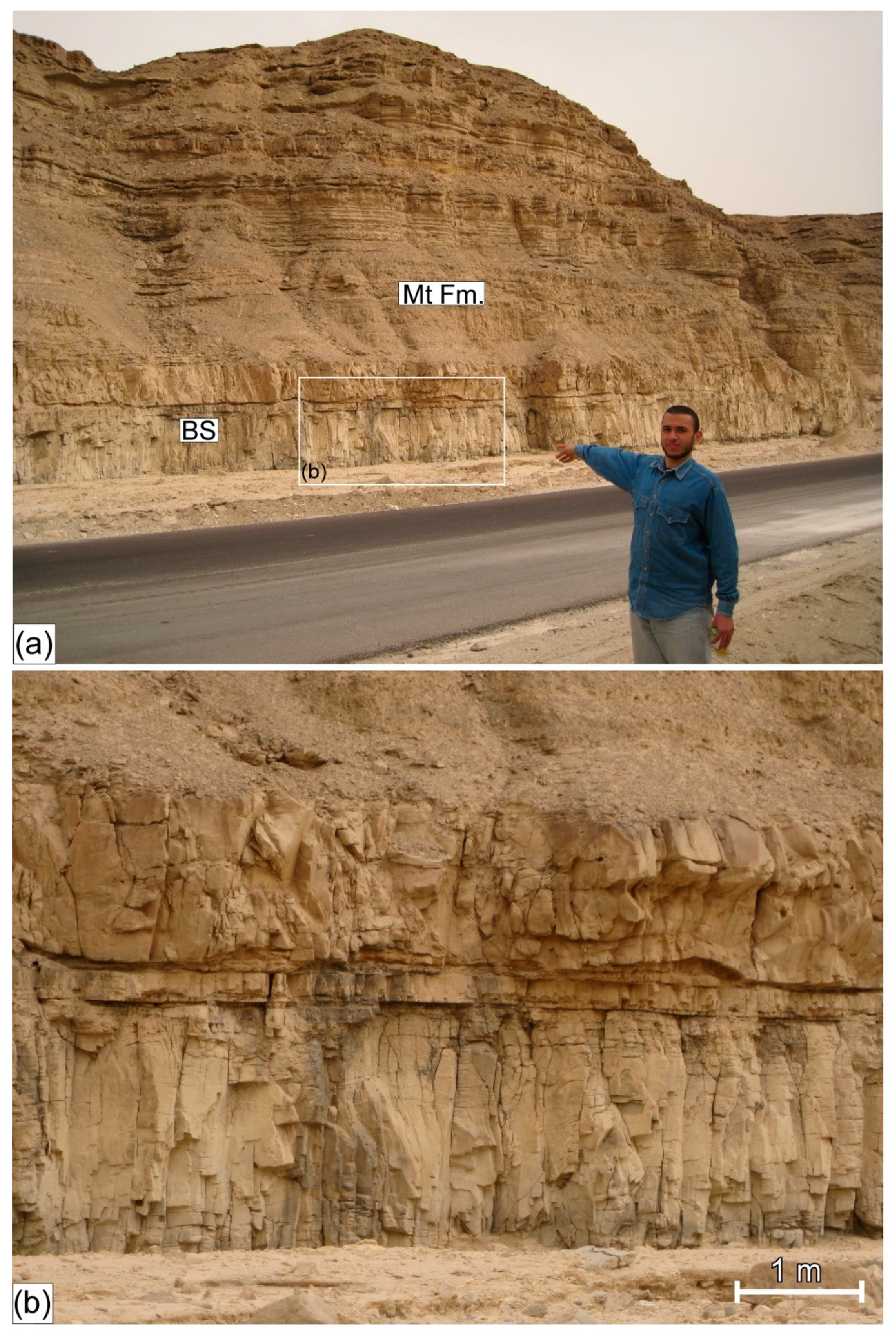
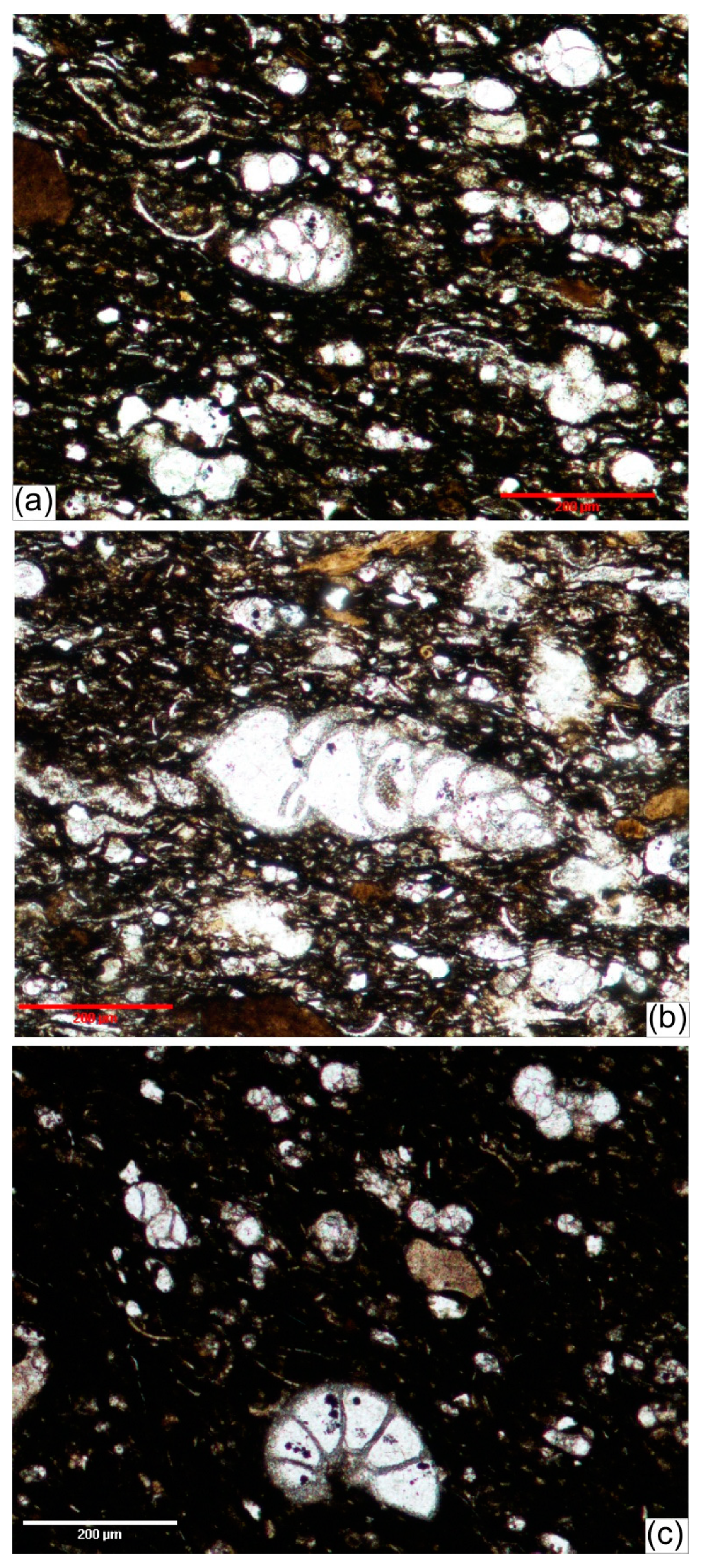
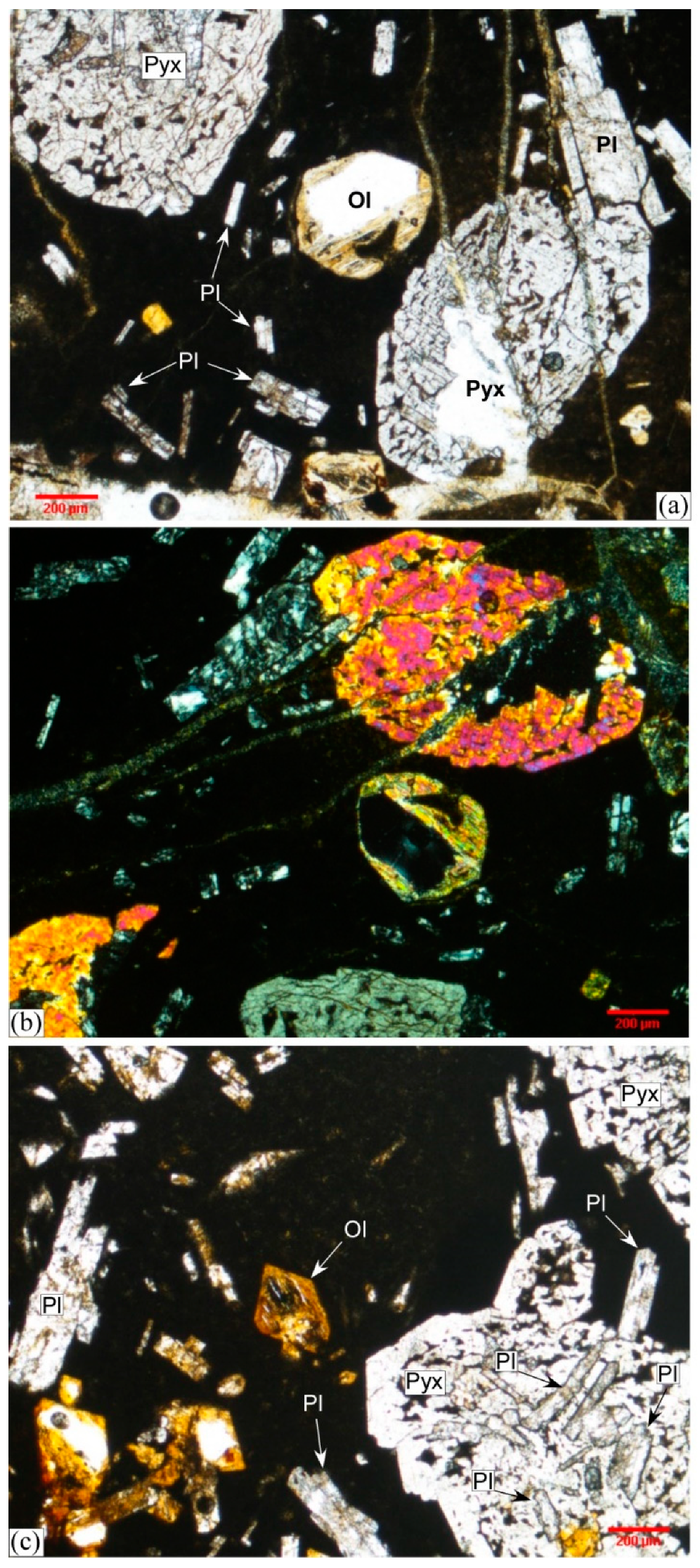
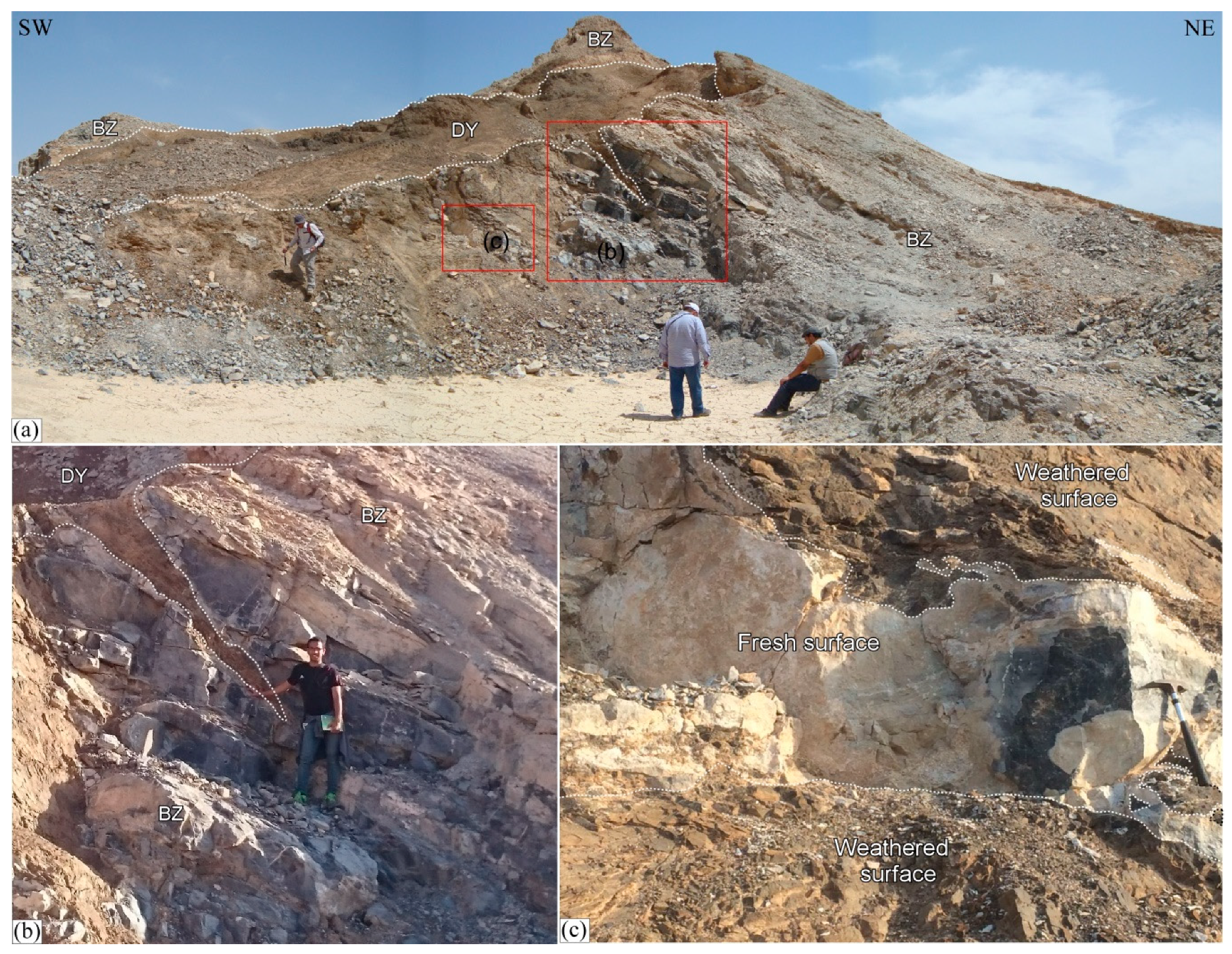

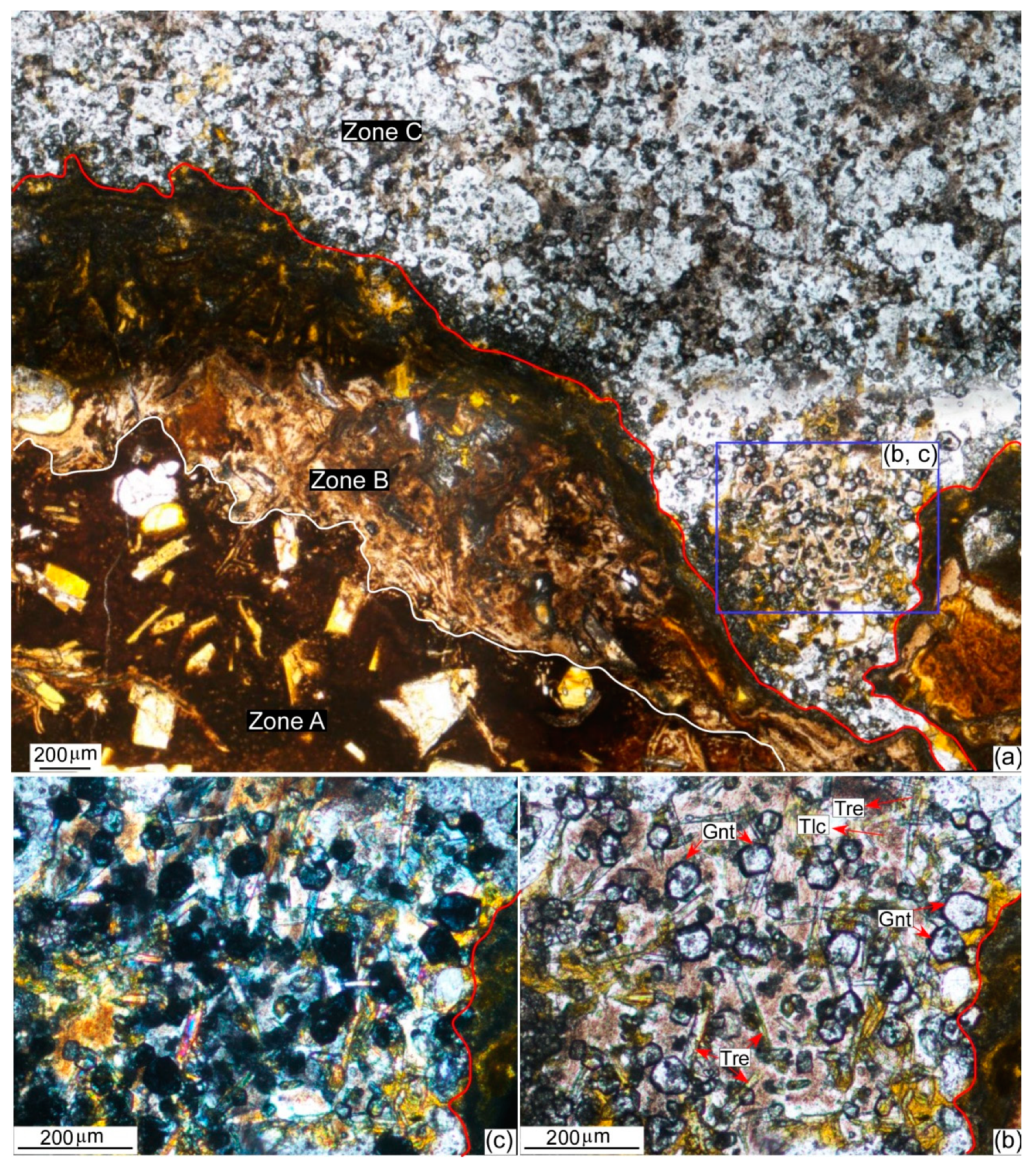
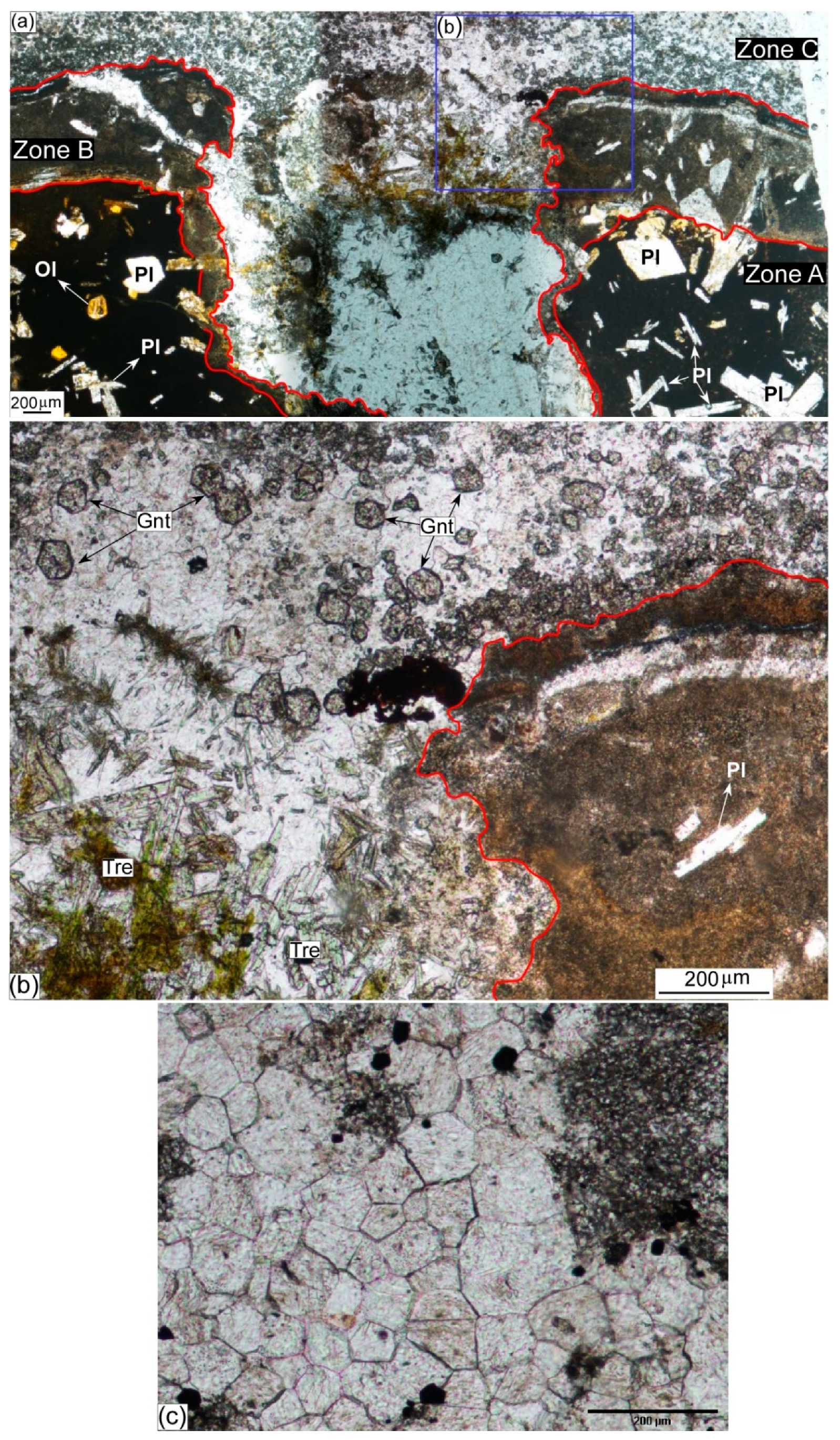

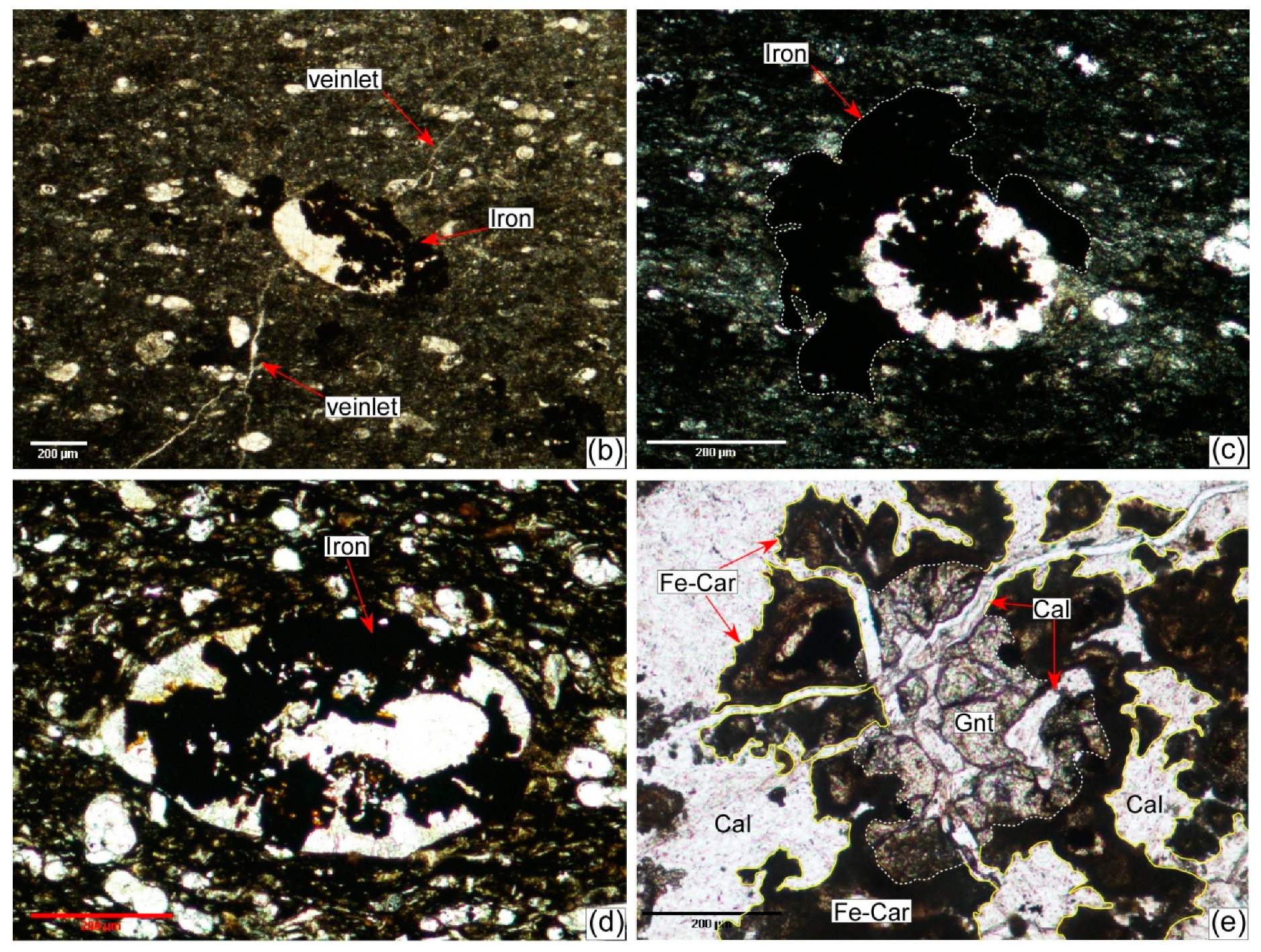
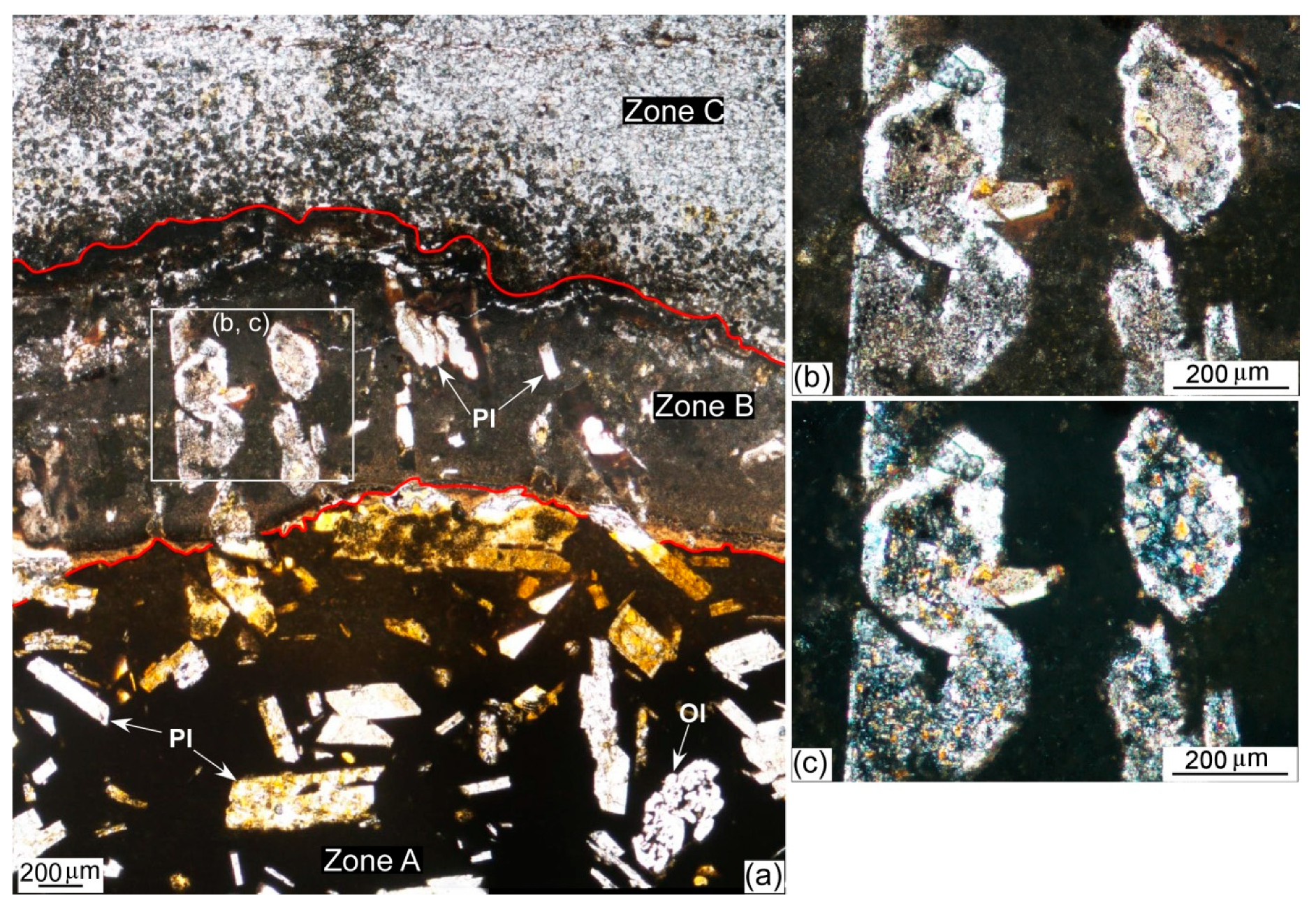
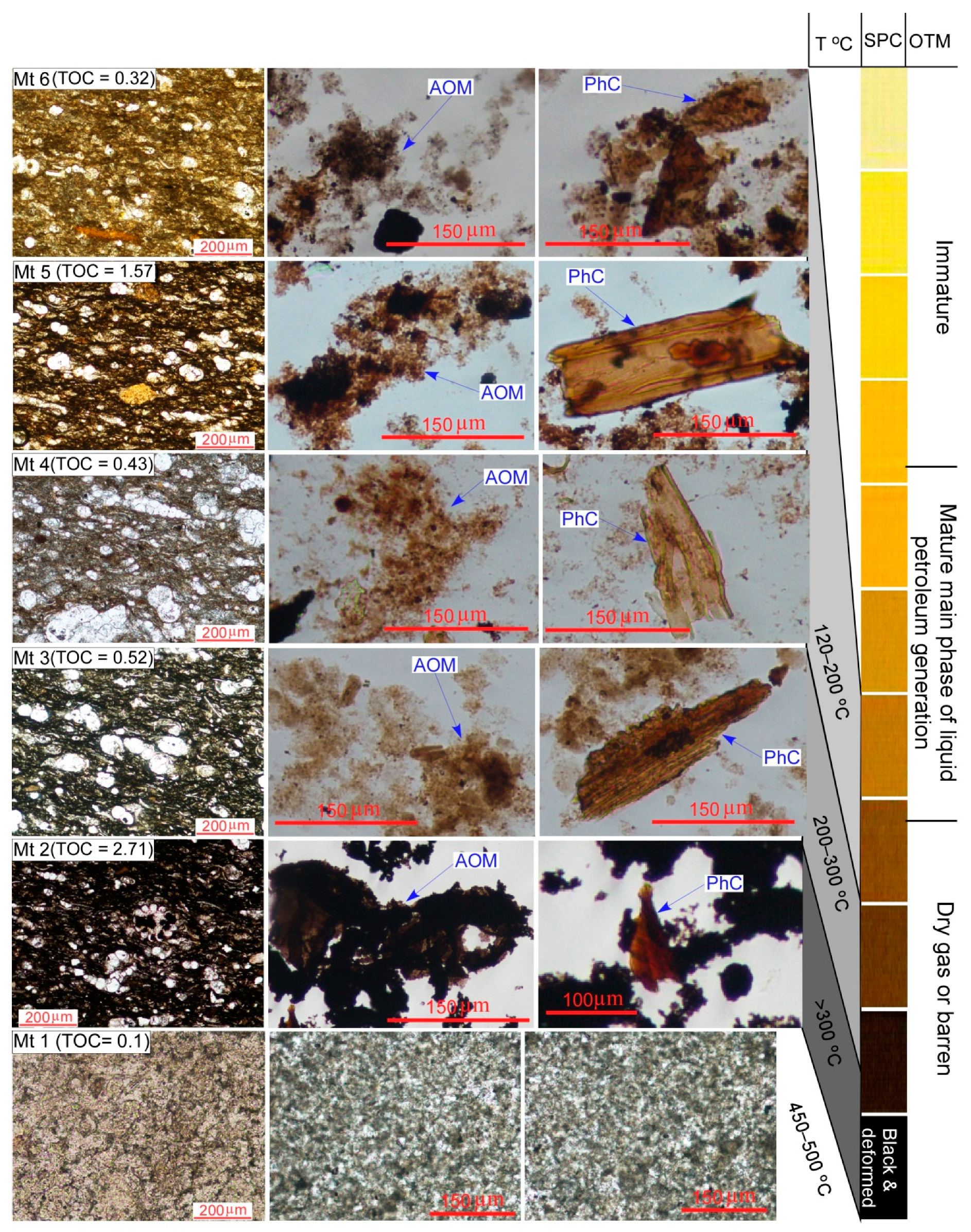
| Formation Name | Sample No. | Color | D (m) | TOC (wt %) | T (°C) |
|---|---|---|---|---|---|
| Sudr | 1 | White | 3 | 0.1 | 450–500 |
| 2 | Black | 5 | 2.71 | >300 | |
| 3 | Brownish grey | 15 | 0.52 | 200–300 | |
| 4 | Light brown | 150 | 0.43 | 120–200 | |
| 5 | Dark brown | 160 | 1.57 | 120–200 | |
| 6 | Greyish brown | 180 | 0.32 | 120–200 |
© 2019 by the authors. Licensee MDPI, Basel, Switzerland. This article is an open access article distributed under the terms and conditions of the Creative Commons Attribution (CC BY) license (http://creativecommons.org/licenses/by/4.0/).
Share and Cite
Abu Sharib, A.S.A.A.; Selim, A.Q.; Abdel Fattah, M.M.; Hassan, S.M.; Sanislav, I.V. Thermal Alteration of Organic Matter in the Contact of a Rift-Related Basaltic Dyke: An Example from the Black Limestone, Wadi Matulla, West Central Sinai, Egypt. Minerals 2019, 9, 279. https://doi.org/10.3390/min9050279
Abu Sharib ASAA, Selim AQ, Abdel Fattah MM, Hassan SM, Sanislav IV. Thermal Alteration of Organic Matter in the Contact of a Rift-Related Basaltic Dyke: An Example from the Black Limestone, Wadi Matulla, West Central Sinai, Egypt. Minerals. 2019; 9(5):279. https://doi.org/10.3390/min9050279
Chicago/Turabian StyleAbu Sharib, Ahmed S. A. A., Ali Q. Selim, Mohamed M. Abdel Fattah, Safiya M. Hassan, and Ioan V. Sanislav. 2019. "Thermal Alteration of Organic Matter in the Contact of a Rift-Related Basaltic Dyke: An Example from the Black Limestone, Wadi Matulla, West Central Sinai, Egypt" Minerals 9, no. 5: 279. https://doi.org/10.3390/min9050279
APA StyleAbu Sharib, A. S. A. A., Selim, A. Q., Abdel Fattah, M. M., Hassan, S. M., & Sanislav, I. V. (2019). Thermal Alteration of Organic Matter in the Contact of a Rift-Related Basaltic Dyke: An Example from the Black Limestone, Wadi Matulla, West Central Sinai, Egypt. Minerals, 9(5), 279. https://doi.org/10.3390/min9050279





